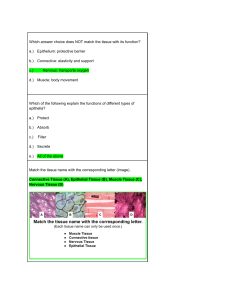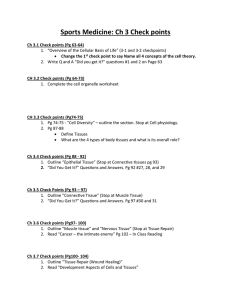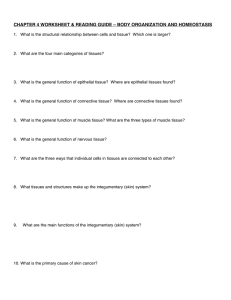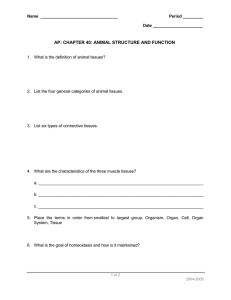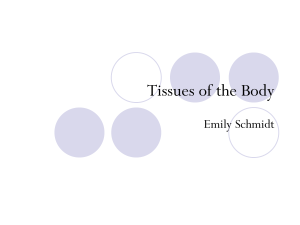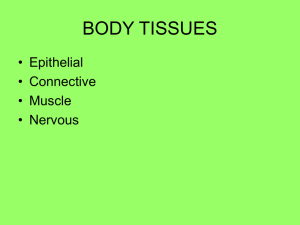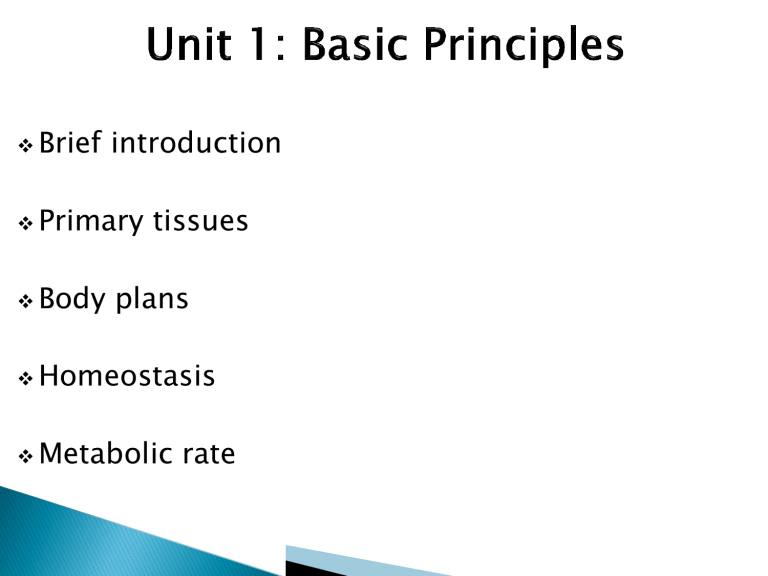
Brief introduction Primary Body tissues plans Homeostasis Metabolic rate 4 critical processes Obtain energy and material Ingest, digest, absorb Obtain oxygen Dispose of CO2 Dispose of nitrogenous waste NH3, urea, uric acid Animals show a correlation between structure and function. Form fits function at all the levels of life, from molecules to organisms. Knowledge of a structure provides insight into what it does and how it works. Conversely, knowing the function of a structure provides insight about its construction. Anatomy organism is the study of the biological form of an Physiology is the study of the biological functions an organism performs The comparative study of animals reveals that form and function are closely correlated Size and shape affect the way an animal interacts with its environment Many different animal body plans have evolved and are determined by the genome The ability to perform certain actions depends on an animal’s shape, size, and environment Evolutionary convergence reflects different species’ adaptations to a similar environmental challenge Physical laws impose constraints on animal size and shape An animal’s size and shape directly affect how it exchanges energy and materials with its surroundings Exchange occurs as substances dissolved in the aqueous medium diffuse and are transported across the cells’ plasma membranes A single-celled protist living in water has a sufficient surface area of plasma membrane to service its entire volume of cytoplasm A single-celled protist living in water has a sufficient surface area of plasma membrane to service its entire volume of cytoplasm Entire surface area in contact with environment Exchange e.g. Amoeba Single cell Multicellular organisms with a sac body plan have body walls that are only two cells thick, facilitating exchange of materials Mouth Gastrovascular cavity Exchange Exchange e.g. Hydra Two cell layers External environment Mouth Food CO2 O2 Respiratory system 0.5 cm A microscopic view of the lung reveals Cells that it is much more spongelike than balloonlike. This construction provides an expansive wet surface for gas exchange with the environment (SEM). 10 µm Heart Nutrients 50 µm Animal body Circulatory system Interstitial fluid Digestive system The lining of the small intestine, a digestive organ, is elaborated with fingerlike projections that expand the surface area for nutrient absorption (cross-section, SEM). Anus Unabsorbed matter (feces) Excretory system Metabolic waste products (urine) Inside a kidney is a mass of microscopic tubules that exhange chemicals with blood flowing through a web of tiny vessels called capillaries (SEM). Organisms with more complex body plans have highly folded Multicellular organisms with a sac body plan have body walls that are only two cells thick, facilitating exchange of materials More complex organisms have highly folded internal surfaces for exchanging materials In vertebrates, the space between cells is filled with interstitial fluid, which allows for the movement of material into and out of cells A complex body plan helps an animal in a variable environment to maintain a relatively stable internal environment Animals are composed of cells Groups of cells with a common structure and function make up tissues Different Which tissues make up organs together make up organ systems Different types of tissues have different structures that are suited to their functions Tissues are classified into four main categories Epithelial Connective Muscle Nervous Epithelial tissue covers the outside of the body and lines the organs and cavities within the body It contains cells that are closely joined shape of epithelial cells may be cuboidal (like dice), columnar (like bricks on end), or squamous (like floor tiles) The The arrangement of epithelial cells may be simple (single cell layer), stratified (multiple tiers of cells), or pseudostratified (a single layer of cells of varying length) Epithelial Tissue Cuboidal epithelium Simple columnar epithelium Pseudostratified ciliated columnar epithelium Stratified squamous epithelium Simple squamous epithelium Apical surface Basal surface Basal lamina 40 µm Connective tissues tissue mainly binds and supports other It contains sparsely packed cells scattered throughout an extracellular matrix The matrix consists of fibres in a liquid, jellylike, or solid foundation There are three types of connective tissue fibre, all made of protein: Collagenous fibres provide strength and flexibility Elastic fibres stretch and snap back to their original length Reticular fibres join connective tissue to adjacent tissues Connective tissue contains cells, including Fibroblasts that secrete the protein of extracellular fibres Macrophages that are involved in the immune system In vertebrates, the fibres and foundation combine to form six major types of connective tissue: Loose connective tissue binds epithelia to underlying tissues and holds organs in place Cartilage is a strong and flexible support material Fibrous connective tissue is found in tendons, which attach muscles to bones, and ligaments, which connect bones at joints Adipose tissue stores fat for insulation and fuel Blood is composed of blood cells and cell fragments in blood plasma Bone is mineralized and forms the skeleton Connective Tissue Loose connective tissue Chondrocytes Cartilage Elastic fibre Chondroitin sulfate Nuclei Fat droplets Adipose tissue Osteon 150 µm Fibrous connective tissue 30 µm 100 µm 120 µm Collagenous fibre White blood cells Blood 55 µm 700 µm Bone Central canal Plasma Red blood cells Muscle tissue consists of long cells called muscle fibres, which contract in response to nerve signals It is divided in the vertebrate body into three types: Skeletal muscle, or striated muscle, is responsible for voluntary movement Smooth muscle is responsible for involuntary body activities Cardiac muscle is responsible for contraction of the heart Muscle Tissue Multiple nuclei Muscle fibre Sarcomere Skeletal muscle Nucleus 100 µm Intercalated disk 50 µm Cardiac muscle Nucleus Smooth muscle Muscle fibres 25 µm Nervous tissue senses stimuli and transmits signals throughout the animal Nervous tissue contains: Neurons, or nerve cells, that transmit nerve impulses Glial cells, or glia, that help nourish, insulate, and replenish neurons Nervous Tissue 40 µm Dendrites Cell body Glial cells Axon Neuron Axons Blood vessel 15 µm Glial cells Axons Blood vessel Glial cells and axons 15 µm In all but the simplest animals different tissues are organized into organs Lumen of In some organs (like the stomach stomach) tissues are arranged in layers Mucosa. The mucosa is an epithelial layer that lines At a higher level of the lumen. organization, organ systems carry out the Submucosa. The submucosa is a matrix of connective tissue major body functions of that contains blood vessels most animals and nerves. Muscularis. The muscularis consists mainly of smooth muscle tissue. Serosa. External to the muscularis is the serosa, a thin layer of connective and epithelial tissue. 0.2 mm Physiological variables: examples Rate at which urine formed by kidney Rate at which sweat is formed Heart rate Concentration of sodium in blood Human body temp & blood sodium concentration: variable- near constant over time Heart rate-variable-show massive increase during exercise Sweat rate-varies in response to env. temp. change-associated with slight change in core body temp Some variables must remain constant at optimum value- for efficient functioning of body Automatic action if these depart from optimum Human body temp- regulated variable Changes in sweating-act to maintain constancy of regulated variable-controlled variable Regulated variables-held at or near constant values as result of changes in other variable Controlled variables-serve to maintain constancy of regulated variable Several processes involved to maintain regulated variables constant Feedback system Forward path e.g. flow of info from university to students Feedback path e.g. flow of response info from students to university Definition: info in feedback path influences that in forward path The effect feeds back to influence the cause Negative feedback- deviation from normal creates a force/action that eliminates the deviation Self correction Positive feedback- deviation is strengthened Self-reinforcing effect Physiological variables regulated by exertion of control over other variables Humans-increase in body temp causes sweating Evaporation of sweat cools body-thus corrects deviation from normal temp Regulation Refers & control associated with homeostasis to constant or near constant Derived from two Greek words meaning ‘similar to standing still’ Organisms use homeostasis to maintain a “steady state” or internal balance regardless of external environment In humans, body temperature, blood pH, and glucose concentration are each maintained at a Mechanisms of homeostasis moderate changes in the internal environment For a given variable, fluctuations above or below a set point serve as a stimulus; these are detected by a sensor and trigger a response The response returns the variable to the set point Response: Heater turned off Room temperature decreases Stimulus: Control center (thermostat) reads too hot Set point: 20ºC Stimulus: Control center (thermostat) reads too cold Room temperature increases Response: Heater turned on Set points and normal ranges can change with age or show cyclic variation Homeostasis can adjust to changes in external environment, a process called acclimatization Thermoregulation is the process by which animals maintain an internal temperature within a tolerable range Endothermic animals generate heat by metabolism; birds and mammals are endotherms Ectothermic animals gain heat from external sources; ectotherms include most invertebrates, fishes, amphibians, and non-avian reptiles In general, ectotherms tolerate greater variation in internal temperature, while endotherms are active at a greater range of external temperatures Endothermy ectothermy is more energetically expensive than body temperature of a poikilotherm varies with its environment, while that of a homeotherm is relatively constant The Poikilotherms: Homeotherms: fish, amphibians, reptiles birds & mammals Organisms exchange heat by four physical processes: conduction, convection, radiation, and evaporation Conduction: the transfer of heat from one molecule to another through a substance (rock) Convection: the transfer of heat from one place to another by the movement of fluids (liquid, gasses) Radiation: process by which energy, in the form of electromagnetic radiation, is emitted by a heated surface in all directions and travels at the speed of light Evaporation: the process by which water is converted from its liquid form to its vapour form Change of water from liquid to gas carries heat away Radiation Convection Evaporation Conduction Five general adaptations help animals thermoregulate: Insulation Circulatory adaptations Cooling by evaporative heat loss Behavioural responses Adjusting metabolic heat production Insulation is a major thermoregulatory adaptation in mammals and birds Skin, feathers, fur, & blubber reduce heat flow between an animal and its environment Blubber is thick layer of fat under skin of marine mammals-e.g. seals & whales The skin temperature of a marine mammal is close to water temperature However, blubber insulation is so effective that marine mammals can maintain body core temperatures of 36–38°C Regulation of blood flow near the body surface significantly affects thermoregulation Many endotherms and some ectotherms can change the amount of blood flowing between the body core and the skin In vasodilation, blood flow to the skin increases, facilitating heat loss In vasoconstriction, blood flow to the skin decreases, lowering heat loss The arrangement of blood vessels in many marine mammals and birds allows for countercurrent exchange Countercurrent heat exchangers transfer heat between fluids flowing in opposite directions Countercurrent heat exchangers are an important mechanism for reducing heat loss Canada goose Bottlenose dolphin Blood flow Artery Vein Vein Artery 35ºC 33º 30º 27º 20º 18º 10º 9º Some bony fishes and sharks also use countercurrent heat exchanges Many endothermic insects have countercurrent heat exchangers that help maintain a high temperature in the thorax Many types of animals lose heat through evaporation of water in sweat Panting increases the cooling effect in birds and many mammals Sweating or bathing moistens the skin, helping to cool an animal down Both endotherms and ectotherms use behavioural responses to control body temperature Some terrestrial invertebrates have postures that minimize or maximize absorption of solar heat Some animals can regulate body temperature by adjusting their rate of metabolic heat production Heat production is increased by muscle activity such as moving or shivering Some ectotherms can also shiver to increase body temperature PREFLIGHT Temperature (ºC) 40 PREFLIGHT WARM-UP FLIGHT Thorax 35 30 Abdomen 25 0 2 Time from onset of warm-up (min) 4 Birds and mammals can adjust their insulation to acclimatize to seasonal temperature changes When temperatures are subzero, some ectotherms produce “antifreeze” compounds to prevent ice formation in their cells Thermoregulation is controlled by a region of the brain called the hypothalamus The hypothalamus triggers heat loss or heat generating mechanisms Fever is the result of a change to the set point for a biological thermostat Sweat glands secrete sweat, which evaporates, cooling the body. Body temperature decreases; thermostat shuts off cooling mechanisms. Thermostat in hypothalamus activates cooling mechanisms. Blood vessels in skin dilate: capillaries fill; heat radiates from skin. Increased body temperature Homeostasis: Internal temperature of 36–38°C Body temperature increases; thermostat shuts off warming mechanisms. Decreased body temperature Blood vessels in skin constrict, reducing heat loss. Skeletal muscles contract; shivering generates heat. Thermostat in hypothalamus activates warming mechanisms.

